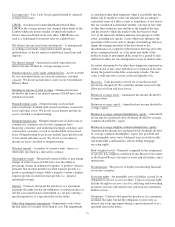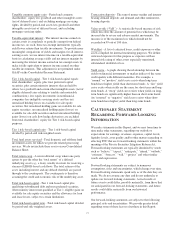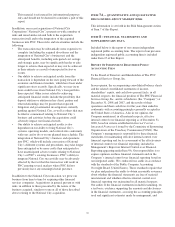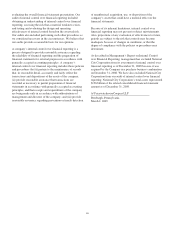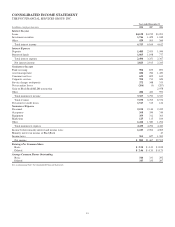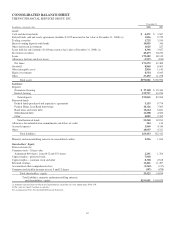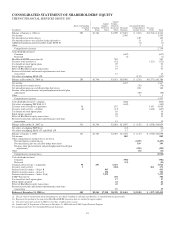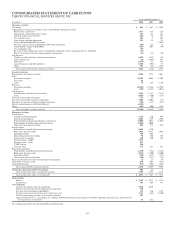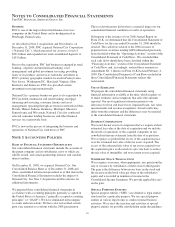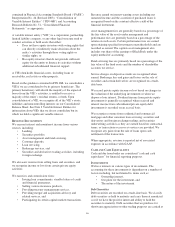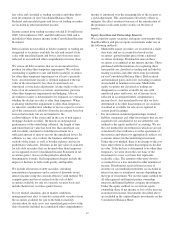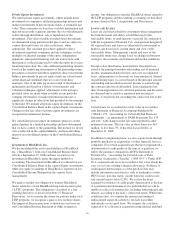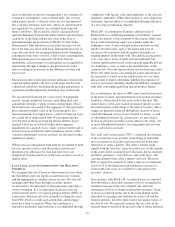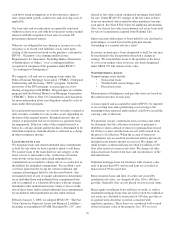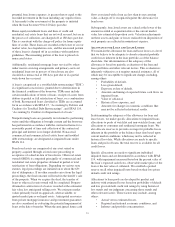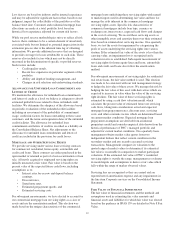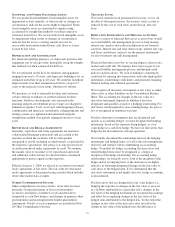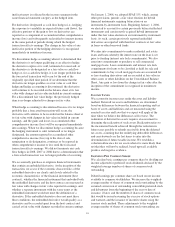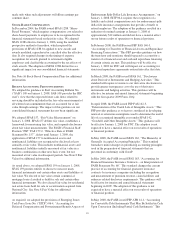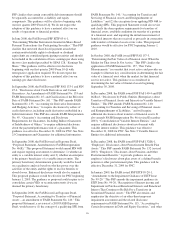PNC Bank 2008 Annual Report Download - page 90
Download and view the complete annual report
Please find page 90 of the 2008 PNC Bank annual report below. You can navigate through the pages in the report by either clicking on the pages listed below, or by using the keyword search tool below to find specific information within the annual report.contained in Financial Accounting Standards Board (“FASB”)
Interpretation No. 46 (Revised 2003), “Consolidation of
Variable Interest Entities” (“FIN 46R”) and Accounting
Research Bulletin No. 51, “Consolidated Financial
Statements,” as appropriate.
A variable interest entity (“VIE”) is a corporation, partnership,
limited liability company, or any other legal structure used to
conduct activities or hold assets that either:
• Does not have equity investors with voting rights that
can directly or indirectly make decisions about the
entity’s activities through those voting rights or
similar rights, or
• Has equity investors that do not provide sufficient
equity for the entity to finance its activities without
additional subordinated financial support.
A VIE often holds financial assets, including loans or
receivables, real estate or other property.
Based on the guidance contained in FIN 46R, we consolidate a
VIE if we are considered to be its primary beneficiary. The
primary beneficiary will absorb the majority of the expected
losses from the VIE’s activities, is entitled to receive a
majority of the entity’s residual returns, or both. Upon
consolidation of a VIE, we recognize all of the VIE’s assets,
liabilities and noncontrolling interests on our Consolidated
Balance Sheet. See Note 3 Variable Interest Entities for
information about VIEs that we do not consolidate but in
which we hold a significant variable interest.
R
EVENUE
R
ECOGNITION
We earn net interest and noninterest income from various
sources, including:
• Lending,
• Securities portfolio,
• Asset management and fund servicing,
• Customer deposits,
• Loan servicing,
• Brokerage services, and
• Securities and derivatives trading activities, including
foreign exchange.
We also earn revenue from selling loans and securities, and
we recognize income or loss from certain private equity
activities.
We earn fees and commissions from:
• Issuing loan commitments, standby letters of credit
and financial guarantees,
• Selling various insurance products,
• Providing treasury management services,
• Providing merger and acquisition advisory and
related services, and
• Participating in certain capital markets transactions.
Revenue earned on interest-earning assets including net
unearned income and the accretion of purchased loans is
recognized based on the constant effective yield of the
financial instrument.
Asset management fees are generally based on a percentage of
the fair value of the assets under management and
performance fees are generally based on a percentage of the
returns on such assets. Certain performance fees are earned
upon attaining specified investment return thresholds and are
recorded as earned. The caption asset management also
includes our share of the earnings of BlackRock under the
equity method of accounting.
Fund servicing fees are primarily based on a percentage of the
fair value of the fund assets and the number of shareholder
accounts we service.
Service charges on deposit accounts are recognized when
earned. Brokerage fees and gains and losses on the sale of
securities and certain derivatives are recognized on a trade-
date basis.
We record private equity income or loss based on changes in
the valuation of the underlying investments or when we
dispose of our interest. Dividend income from private equity
investments is generally recognized when received and
interest income from subordinated private equity debt
investments is recorded on an accrual basis.
We recognize revenue from residential and commercial
mortgage and other consumer loan servicing; securities and
derivatives and foreign exchange trading; and securities
underwriting activities as they are earned based on contractual
terms, as transactions occur or as services are provided. We
recognize any gains from the sale of loans upon cash
settlement of the transaction.
When appropriate, revenue is reported net of associated
expenses in accordance with GAAP.
C
ASH AND
C
ASH
E
QUIVALENTS
Cash and due from banks are considered “cash and cash
equivalents” for financial reporting purposes.
I
NVESTMENTS
We have interests in various types of investments. The
accounting for these investments is dependent on a number of
factors including, but not limited to, items such as:
• Ownership interest,
• Our plans for the investment, and
• The nature of the investment.
Debt Securities
Debt securities are recorded on a trade-date basis. We classify
debt securities as held to maturity and carry them at amortized
cost if we have the positive intent and ability to hold the
securities to maturity. Debt securities that we purchase for
short-term appreciation or other trading purposes are carried at
86


